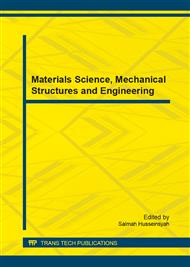p.81
p.85
p.89
p.93
p.97
p.102
p.106
p.111
p.115
Experimental Study on the Single-Sided Double-Point Resistance Welding of Bus Roof Skin
Abstract:
In order to weld the skin and skeleton of bus roof, it analysis the welding process of bus Outer Roof-panels , and specify the weld area and solder joint distance of outer roof-panel firstly , then built a single-sided double-point resistance welding experiment platform for bus outer roof-panels, the platform consists of guide、gantry、gantry moving mechanism、 pneumatic torch、electrode support mechanism、transformers、torch lateral movement organizations and torch longitudinal movement phenomenon . it set the unevenness of the skin and the skeleton as 1mm, single-sided double-point resistance welding experiment was conducted on the welding experiment platform. The experimental results of welding area visual examination and tear experiments indicate that welding heat will penetrate the skeleton when the welding current is greater than 11.0KA;the welding Reliability of galvanized steel is better than low carbon steel.
Info:
Periodical:
Pages:
97-101
Citation:
Online since:
October 2014
Authors:
Price:
Сopyright:
© 2014 Trans Tech Publications Ltd. All Rights Reserved
Share:
Citation:


